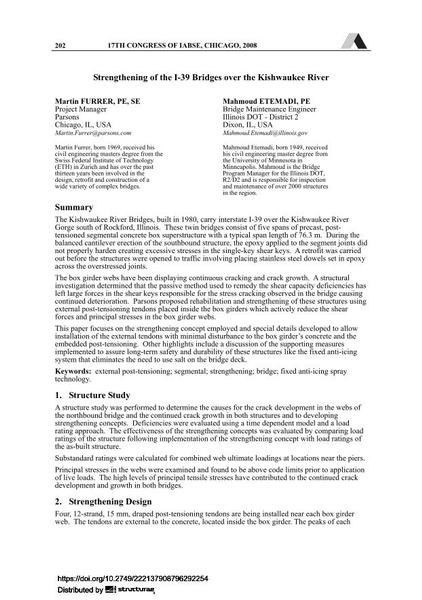Strengthening of the I-39 Bridges over the Kishwaukee River

|
|
|||||||||||
Bibliographic Details
| Author(s): |
Martin Furrer
Mahmoud Etemadi |
||||
|---|---|---|---|---|---|
| Medium: | conference paper | ||||
| Language(s): | English | ||||
| Conference: | 17th IABSE Congress: Creating and Renewing Urban Structures – Tall Buildings, Bridges and Infrastructure, Chicago, USA, 17-19 September 2008 | ||||
| Published in: | IABSE Congress Chicago 2008 | ||||
|
|||||
| Page(s): | 202-203 | ||||
| Total no. of pages: | 8 | ||||
| Year: | 2008 | ||||
| DOI: | 10.2749/222137908796292254 | ||||
| Abstract: |
The Kishwaukee River Bridges, built in 1980, carry interstate I-39 over the Kishwaukee River Gorge south of Rockford, Illinois. These twin bridges consist of five spans of precast, post- tensioned segmental concrete box superstructure with a typical span length of 76.3 m. During the balanced cantilever erection of the southbound structure, the epoxy applied to the segment joints did not properly harden creating excessive stresses in the single-key shear keys. A retrofit was carried out before the structures were opened to traffic involving placing stainless steel dowels set in epoxy across the overstressed joints. The box girder webs have been displaying continuous cracking and crack growth. A structural investigation determined that the passive method used to remedy the shear capacity deficiencies has left large forces in the shear keys responsible for the stress cracking observed in the bridge causing continued deterioration. Parsons proposed rehabilitation and strengthening of these structures using external post-tensioning tendons placed inside the box girders which actively reduce the shear forces and principal stresses in the box girder webs. This paper focuses on the strengthening concept employed and special details developed to allow installation of the external tendons with minimal disturbance to the box girder’s concrete and the embedded post-tensioning. Other highlights include a discussion of the supporting measures implemented to assure long-term safety and durability of these structures like the fixed anti-icing system that eliminates the need to use salt on the bridge deck. |
||||
| Keywords: |
bridge strengthening segmental external post-tensioning fixed anti-icing spray technology
|
||||
